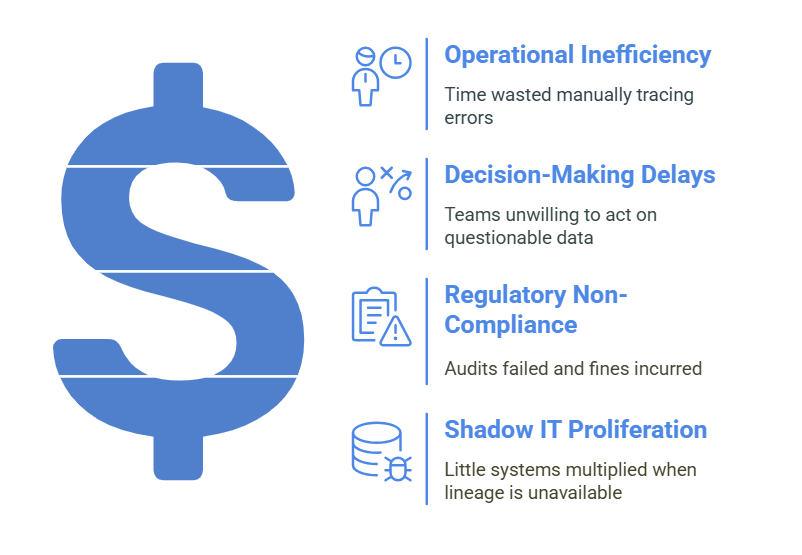- June 23, 2025
If you can’t see your data, you can’t trust it!
According to Gartner, 80% of data and analytics governance initiatives will fail by 2025 due to a lack of effective metadata management.
That’s a wake-up call. Data lineage, the ability to trace data from its origin to its end use has become non-negotiable in a world where businesses depend on data for every decision.
Without it, organizations are flying blind, risking compliance breaches, inaccurate reports, and poor strategic calls. In today’s landscape, where AI in data management is transforming enterprise operations, not having a robust lineage strategy is a major competitive risk. But what if AI could illuminate every step your data takes, in real time?
Enter AI-powered data lineage!!
What Data Lineage is and why it cannot be avoided today
Essentially, data lineage talks about the life journey of data from the source till its destination. This encompasses how data traverses among systems, the transformations it goes through, and finally, where it ends up. This is no longer a nice-to-have in today’s regulatory-heavy climate.
AI-powered data lineage tools for compliance are proving to be vital, especially as organizations face increasing scrutiny on how data is used, stored, and accessed.
Effective data lineage is critical for:
- Compliance with standards like GDPR, HIPAA, and SOX.
- Data transparently trusted.
- Root cause analysis speeded up in conducting outages/errors.
Organizations will end up having data mistrust and failed audits, therefore missing insights.
Data transparency challenges without lineage tools create roadblocks in business agility and decision-making.
Can’t govern what can’t be seen pretty much tells the story.
The real costs of bad or absent data lineage

Don’t ever, ever say, “We’ll deal with data lineage later.” Consider the price:
Operational inefficiency: Time wasted manually tracing errors.
Longer lead times when making decisions: Teams unwilling to act on questionable data.
Audits failed and fines incurred: Particularly regarding GDPR, HIPAA, and SOX.
Shadow IT: Little systems multiplied when lineage is unavailable.
These are not theoretical problems.
According to IDC, businesses lose an average of $15 million yearly as a result of poor quality and visibility of data. That loss isn’t just monetary, it undermines enterprise-wide data governance and trust.
According to IDC, businesses lose an average of $ 15 million yearly as a result of poor quality and visibility of data.
Why traditional data lineage does not work anymore
Old approaches to data lineage are based on extensive manual mapping and utilizing outdated spreadsheets and static documentation. All the following:
- No real-time tracking;
- Have challenges with modern data stacks and unstructured sources;
- Harness high maintenance;
- Unable to scale in hybrid or multi-cloud environments.
And frankly, nobody has time to update those diagrams.
Manual lineage processes often lack the scalability required in hybrid cloud environments. This highlights the critical risks of manual data lineage processes in fast-evolving ecosystems.
Machine-AI-powered Data Lineage: A revolution of change
AI-powered data lineage automation automates the whole mapping process while providing real-time visibility into how data moves across your systems. It does that by:
- Automatically discovering metadata across platforms.
- Using machine learning to infer relationships even when it comes to unstructured data.
- Mapping dependencies, transformations, and impact paths.
- Updating lineage views continuously in real time.
This is how AI automates data lineage mapping, unlocking a new era of visibility and speed. This is the best practice in data lineage automation because it liberates teams from tedious exercises and enhances data governance and transparency.
Key benefits of employing AI in Data Lineage

So why are more enterprises investing in AI-powered data lineage tools, right from compliance to analytics? Here are the keys:
- Improved trust in data: Know where your data came from and what was done to it.
- Faster root cause analysis: Identify problems in seconds.
- Regulatory compliance: Confidently create defensible audit trails.
- Reduced manual work: Let the AI do the grunt work.
- Unified metadata management: See your whole data universe in one place.
- Agility: Quickly act and be confident with agile data teams.
The benefits of using AI for data lineage tracking go beyond automation, it establishes a proactive governance culture.
How AI resolves Data Lineage for complex environments
This is what a modern environment is on-prem, hybrid, and multi-cloud ecosystems. Traditional lineage tools aren’t cutting it as they should be. AI in data management now enables organizations to handle scale, diversity, and speed across data landscapes.
AI made possible:
- Hybrid and multi-cloud support
- Integration with other modern tools such as Snowflake, Databricks, Power BI, and many more
- Scalability over millions of data points
AI provides real-time visibility into data flows, even when source documentation is incomplete or unavailable.
For instance, AI scans logs, ETL pipelines, and code to derive lineage even when the source documentation is missing. That’s how machine learning for metadata discovery and lineage brings clarity into complex data environments.
Real-World application: Who uses it and why
Finance: 40% less time is spent getting ready for audits, with the help of AI lineage in tracking data used for regulatory reporting.
Healthcare: Tracing the information in the patient data access and transformations, compliance with HIPAA.
Manufacturing: Knowing the actual root causes of quality issues through data flow mapping.
Energy: Improved analysis of smart meters and consumption trends.
These are enterprise use cases of AI in data governance, driving operational efficiency and risk reduction.
As Decube mentions, organizations implementing AI for lineage are resolving issues at 60% faster turnaround time and with a 70% improvement in data transparency.
As Decube mentions, organizations implementing AI for lineage resolving issues at 60% faster turnaround time and with a 70% improved data transparency.
Choosing the right tools for AI-Powered lineage
There is no best tool to use. When evaluating, seek the following criteria:
- Auto-discovery and mapping
- Pre-built integrations with your data stack
- Impact analysis and reporting dashboards
- Role-based access and data masking
Top tools to explore: Informatica, Atlan, Decube, Secoda, SAS Viya.
If you’re exploring how to implement AI-powered data lineage solutions, choose platforms that can scale with your architecture.
Checklist: Getting started; an action plan for data leaders
Do not try to boil the whole ocean at once. Here is how to start:
- Audit your current data flows.
- Identify critical systems and high-risk areas.
- Start small with tools that automate.
- Align IT, governance, and BI teams.
- Track the progress of lineage maturity and revise regularly
Understanding the importance of automated data lineage in governance will help you prioritize what matters most. Most platforms provide free trials or demos if you want to help.
Final thoughts: From blind to brilliant with AI
Data lineage is no longer optional. This is the backbone of trust, compliance, and intelligent decision-making. Today’s complexity cannot be matched by manual approaches. Such lineage not only automates the process but also transforms how one sees and manages data in intelligent terms.
AI-powered data lineage helps enterprises shift from reactive to proactive governance while building resilient, insight-driven organizations.
Start small. Automate smart. Believe in your data again!
Happy Learning!!
FAQ:
What is data lineage and why is it so important?
Data lineage refers to the ability to track and visualize the journey of data as it moves through various systems, transformations, and processes. It’s essential for data transparency, building trust, supporting compliance, and ensuring accurate business intelligence across the organization.
What are the risks of not having data lineage?
Without effective lineage, organizations face operational inefficiencies, compliance risks, failed audits, and poor decision-making. It becomes difficult to trace data errors, leading to wasted time and significant business disruption.
How does AI improve data lineage?
AI eliminates the need for manual mapping by automatically discovering and tracking data relationships across platforms. It uses machine learning to provide real-time updates, identify dependencies, and simplify metadata management enabling fast, reliable, and scalable data governance.
Which industries would benefit the most from such AI-backed data lineage?
Industries like finance, healthcare, manufacturing, and energy all of which handle sensitive, complex, or regulated data benefit greatly from AI-powered lineage tools due to their ability to improve accuracy, audit-readiness, and risk management.
What is the difference between manual and automated data lineage?
Manual approaches involve static documentation that quickly becomes outdated. In contrast, AI-powered data lineage automation delivers dynamic, real-time insights, supports modern data architectures, and reduces operational overhead.
Can AI-powered data lineage help in terms of regulatory compliance?
Absolutely. These solutions create defensible audit trails and ensure traceability, which is crucial for meeting standards like GDPR, HIPAA, SOX, and others. Compliance teams can generate reports faster and with more accuracy.
How do I get started with AI-powered data lineage?
Begin with a clear audit of your current data flows, identify high-risk systems, and gradually introduce tools that offer automated lineage tracking. Collaboration among IT, governance, and analytics teams is key to long-term success.
What are the best AI-powered data lineage tools available?
Some of the top tools include Informatica, Atlan, Secoda, Decube, and SAS Viya each offering different strengths such as metadata discovery, integration support, compliance reporting, and real-time data flow tracking.




